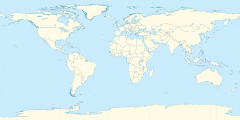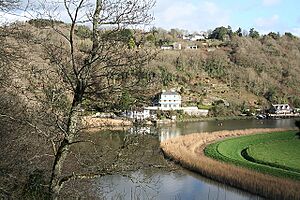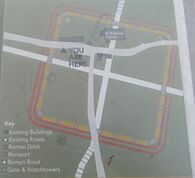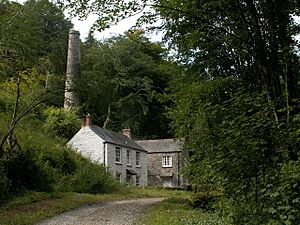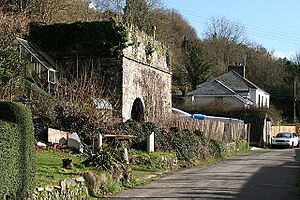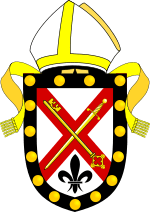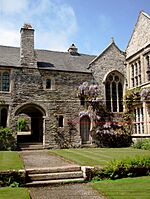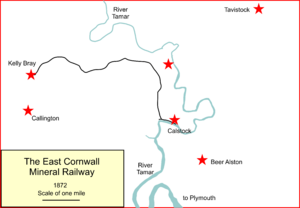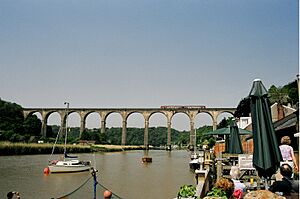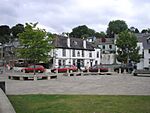Calstock facts for kids
Quick facts for kids Calstock
|
|
|---|---|
| Village and civil parish | |
 Calstock village from the viaduct |
|
| Area | 23.79 km2 (9.19 sq mi) |
| Population | 6,253 2011 Census including Albaston , Dimson and Latchley |
| • Density | 263/km2 (680/sq mi) |
| OS grid reference | SX4368 |
| • London | 191 Miles |
| Civil parish |
|
| Unitary authority | |
| Ceremonial county |
|
| Region | |
| Country | England |
| Sovereign state | United Kingdom |
| Post town | CALSTOCK |
| Postcode district | PL18 |
| Dialling code | 01822 |
| EU Parliament | South West England |
| UK Parliament |
|
| Website | Calstock |
Calstock (Cornish: Kalstok) is a large village and a civil parish in south east Cornwall, England. It is located right on the border with Devon. The village sits on the River Tamar, about 6 miles (10 km) southwest of Tavistock. It is also about 10 miles (16 km) north of Plymouth.
In 2011, the parish had a population of 6,431 people. The area covers about 5,760 acres (23.3 sq km) of land. It also includes 70 acres (0.28 sq km) of water and 44 acres (0.18 sq km) of the tidal River Tamar.
Besides Calstock village itself, the parish includes other small communities. These are Albaston, Chilsworthy, Gunnislake, Harrowbarrow, Latchley, Metherell, Coxpark, Dimson, Drakewalls, Norris Green, Rising Sun and St Ann's Chapel.
Calstock village is part of the beautiful Tamar Valley Area of Outstanding Natural Beauty. It is overlooked by the historic Cotehele house and gardens. The village is also on the scenic Tamar Valley railway. Calstock railway station first opened on March 2, 1908. Calstock is twinned with Saint-Thuriau in Brittany, France.
Contents
Calstock's Ancient Past
Scientists have dug up and studied Church Hill in Calstock. Between 2007 and 2011, they found signs of people living there a very long time ago. This includes evidence from the Early Bronze Age, around 2200-2000 BCE.
Later, in the Late Iron Age (500-350 BCE), the hill was surrounded by a protective wall. The Romans might have used this old Iron Age fort. They built their own, smaller, square Roman fort there. This Roman fort was about 170 by 160 meters in size. It is only the third Roman fort found in Cornwall, and it is the largest.
The Roman fort was probably built around 50-55 CE. This was at the same time as a large Roman army base in Exeter. Up to 500 soldiers might have lived here. More recent digs have found a Roman mine with tunnels. There is also proof of a Roman road nearby. The fort was used for about 30 years. Around 75 CE, the Roman army unit moved to South Wales. Other Roman soldiers stayed in Devon and Cornwall. The fort was likely left around 80-85 CE. Its buildings were taken apart, and the walls were flattened. People did not live on the hill again until the 8th century CE. Today, part of the Roman site is where St Andrew's Church stands. You can find more details on a special sign near the church.
In Saxon times, Calstock was part of the Kingdom of Cornwall. This kingdom tried to stop the spread of Wessex from the east. In 838 CE, Wessex had reached the River Tamar. A battle for independence was fought near Calstock.
After the Norman Conquest, Calstock manor was listed in the Domesday Book. It was called Callestock. The Saxon manor was taken over. In the 14th century, it became part of the Duchy of Cornwall. This was one of the 17 oldest manors. In 1086, the manor was held by Reginald. He held it for Robert, Count of Mortain. The manor was later sold by the Duchy around 1807.
During the English Civil War, Calstock was a base for the Royalists. These were supporters of the King. About 1,200 Cornishmen were based there. They stayed at Cotehele and Harewood House. During the war, the Parliamentarians attacked Gunnislake New Bridge. It was defended by Sir Richard Grenville and Captain Southcote. They were from the Calstock base. The bridge was lost to the Parliamentarians. However, they could not go further into Cornwall. King Charles I praised Calstock and Cornwall for their loyalty. The King's letter to the Cornish people is still at St Andrew's Church, Calstock.
Local Industries
Mining History
Mining was very important in Calstock, even back in Mediaeval times. The Duchy mined silver here. The industry grew a lot in the late 1800s. Copper was found, and nearby granite was quarried. This made Calstock a very busy port. Many people moved to Calstock for work. This led to a serious illness outbreak in 1849. The mining industry slowed down in the early 1900s. This was because of competition from other countries. Today, only the ruined pump houses are left. You can see them dotted across the landscape.
Calstock had many mines. Some of the main ones were:
- Cotehele Consol - mined copper and arsenic.
- Calstock Consol - mined copper.
- Okeltor Consol - mined copper, tin, arsenic, silver.
- Wheal Trelawny - mined copper.
- Danescombe Mines - mined copper, tin, arsenic.
- Wheal Zion - mined copper.
- Wheal Edward - mined copper and arsenic.
- Wheal Arthur - mined copper and arsenic.
River Transport

The River Tamar is deep enough for boats to travel past Calstock. They can go about 3 miles (5 km) upstream to Morwellham Quay. Calstock Quay and Danescombe Quay were once very important. They were used to transport minerals from the mines. In the Victorian era, steamers brought tourists to the village. Even Queen Victoria and Prince Albert visited Calstock in 1846. Tourist boats still run from Plymouth to Cotehele in the summer. The river became less important for transport. This was after the 14-mile (23 km) Tamar Valley railway was built. The village is still famous for its large railway viaduct.
Boat Building
The river has its own special type of boat, called the Tamar barge. Calstock had two main boat builders. Goss's Yard built the West Country Ketch Garlandstone. This ship is now at the Morwellham Quay museum. May's Yard was in the Danescombe Valley. The Garlandstone was built to keep workers busy when there was less repair work. A Tamar barge called Shamrock is kept safe by the National Trust. It is at Cotehele Quay. Another barge, Lynher, was also built by James Goss. It is now privately owned.
Lime Production
There are four sets of lime kilns in Calstock. More kilns were found at Cotehele Quay. Burning lime was a big industry here in the 1800s. Limestone was brought to the kilns by boat. The finished lime was then taken to farms by horse and cart. It was used to make soil better for growing crops. It was also used in paint and as a type of glue for bricks.
Churches in Calstock
St Andrew's Parish Church
The church is believed to have been officially opened around 1290. Not much from that time is still visible today. However, the pillars and arches on the north side are from the early 1300s. Around 1420, the south side was added, and a new roof was put on the whole church. In 1861, a survey found the church needed a lot of repair. So, in 1867, it was fully restored. The floor was changed, old tiles were put back, and new wooden benches were added. Even with these big changes, many interesting old parts of the church were saved. Also, three smaller chapels were built in Gunnislake, Harrowbarrow, and Latchley. These were needed because the population grew due to the mines.
St. Anne's, Gunnislake
The land for this church was bought in 1879. The church cost £2,400 to build. The Duke of Bedford gave £500, and a church building group gave £200. The first stone was laid on September 30, 1879. The church was designed by J. Piers St Aubyn. It was opened by the Bishop of Truro in 1880. It was named St. Anne because of an old holy well nearby. The church can hold up to 225 people. In 1918, Gunnislake tried to become its own separate parish, but they could not raise enough money.
All Saints, Harrowbarrow
In 1870, a local person gave the church some land near the Prince of Wales Mine. The church was designed by J. Piers St Aubyn. It was built for £700 to be both a school and a small chapel. This church can hold up to 80 people.
Albaston Chapel
The graveyard in front of this chapel was officially opened in 1888. Just inside the main gate, there is a large granite cross. This cross is a war memorial for 132 men from Calstock parish. They died in the Great War (1914–1918). The cross has a special message carved into it:
Thanks be to God which giveth us the victory. In glorious memory of the men from the parish of Calstock who fell in the Great War 1914–1918. Greater Love hath no man than this that a man lay down his life for his friends.
St Michael and All Angels, Latchley Church
In 1879, the first stone for this church was laid. Latchley church was designed by Piers St Aubyn, who also designed the Gunnislake church. It was built three years after Gunnislake, costing £1,147. It was a small chapel dedicated to St Michael and All Angels. The Bishop of Truro opened it on July 20, 1883. In August 1968, the building had a bad problem with woodworm. It was then closed for worship. In 1985, it was sold and became a home.
Cotehele's Chapels
St. Katharine, House Chapel Cotehele
At Cotehele, on the west side of Hall Court, you can find the vicarage and a chapel. This chapel is dedicated to St. Katharine and St. Anne. It connects to the main house through a small hallway. The chapel is one of the oldest rooms in the house, along with the Great Hall. It still has its original clock. This is a rare clock from the Tudor period that still works today.
St. Thomas Becket, Woodland Chapel Cotehele
In the grounds of Cotehele, east of the house and near the River Tamar, is a quiet, simple chapel. Inside, there are benches along the walls, two seats for ministers, and a fancy table. The chapel is named after St. Thomas Becket.
Sports and Schools
Cornish Wrestling
Cornish wrestling competitions were held at the Bridge Inn in Calstock. These events took place in the 1800s and 1900s. Tournaments were also held at St Ann's Chapel and Albaston.
Primary School
Calstock Community Primary School was built in 1901. It opened its doors on January 6, 1902. At that time, the school only had two main classrooms. It has since been made bigger with a new area for younger children. This new part won an award for its design, as it fits well with the rest of the school. The school celebrated its 100th birthday in the summer of 2002. In 2014, Stoke Climsland School joined with Calstock. This helped them share resources. Most students from Calstock go on to Callington Community College. Some also go to Devonport High School for Boys or Girls.
Calstock's Railways
East Cornwall Mineral Railway
The East Cornwall Mineral Railway was a railway line that opened in 1872. It was built to connect mines and quarries near Callington and Gunnislake. It linked them to ships at Calstock on the River Tamar. The line had a special slope where wagons were pulled by ropes. This helped goods from the mines get down to the quay at Calstock. Wagons came down a 0.4-mile (0.6 km) cable-worked incline. It had a steep slope of 1 in 6 (17%).
Later, a new railway line was built. It connected to the main LSWR line at nearby Bere Alston. The old line was changed to a standard size. It opened for passengers in 1908. In the 1960s, many country railway lines were closed. However, a short part of the original line was kept open. This kept a connection from Plymouth to Gunnislake. That part of the line is still open today.
Calstock Viaduct
The Calstock Viaduct is a very tall bridge. It is 120 feet (37 meters) high. It has twelve wide arches, each 60 feet (18 meters) across. There is also a smaller arch at the Calstock end. Three of the bridge's supports stand in the River Tamar. The river here is affected by tides. At high tide, there is at least 110 feet (34 meters) of space under the bridge.
The viaduct was built between 1904 and 1907. John Lang of Liskeard built it using 11,148 concrete blocks. These blocks were made in a temporary yard on the Devon side of the river. The engineers for the project were Richard Church and W. R. Galbraith. The first train crossed the viaduct on August 8, 1907. Passengers first used it on March 2, 1908. It is now a Grade II* listed building, meaning it is a very important historic structure.
Train Services
Calstock has train services on the Tamar Valley Line. These trains run from Gunnislake to Plymouth. You can connect to main train lines at Plymouth. A few Tamar Valley trains also go to or from Exeter St Davids.
Local Life and Government
Literary Connections
The company Peterloo Poets published poetry. It was started by Harry Chambers. This company was based in Calstock until it closed in 2009. Before that, Peterloo Poets was in Liskeard. In 2010, Harry Chambers was honored for his work in poetry.
Local Places to Visit
In Victorian times, Calstock parish had "13 churches and 13 taverns" (pubs). Today, the parish has four churches and nine taverns. These include the Tamar Inn, located on Calstock Quay. It dates back to the 1600s. People used to say it was a place for smugglers and highwaymen. The Boot Inn, in the middle of the village, was built in 1666.
Calstock has a non-league football club. They play in the second division of the Duchy League. Their home field is on Calstock Quay, by the River Tamar. The club's nickname is The Bees. Their logo uses Cornwall's black and gold county colors. Local volunteers run the club. The Tamar Inn sponsors them.
Local Government
In 1894, Calstock parish became its own rural district, called Calstock Rural District. At that time, Calstock had many people living there. In 1934, this rural district was ended. It joined with Callington Urban District to form St Germans Rural District. Then, in 1974, the St Germans Rural District joined with Liskeard Rural District to form Caradon. In 2009, Caradon was ended. Now, all of Cornwall is run by one main council, Cornwall Council.
Parish Council
Calstock Parish Council is the lowest level of local government. The parish council was created in 1934. This was after Calstock Rural District joined with the Rural District of St Germans. Eighteen councillors are chosen from the five areas of the parish. These areas are Calstock, Chilsworthy, Delaware, Gunnislake and Harrowbarrow. The council meets at the Tamar Valley Centre in Drakewalls.
Local Symbols
| Coat of Arms of the Calstock Parish Council |
|
|---|---|
| Adopted | 2016 |
| Blazon | Sable, Cross Argent, Calstock Viaduct Argent, Two Strawberries Gules, Daffodil Or, Engine House Argent and Picaxe Argent |
| Use | For the Calstock Parish Council |
The Calstock Parish Council has its own special symbol, called a Coat of Arms. It was adopted in 2016. It shows symbols important to the area. These include the Calstock Viaduct, strawberries, a daffodil, an engine house, and a pickaxe.
Freemasonry
Calstock has a long history with Freemasonry. Cotehele Lodge No. 2166 was officially started in June 1886. Its first meeting was in April 1887 at Cotehele House. Twelve local men founded it. The Earl of Mount Edgcumbe, a leader in Freemasonry, greatly supported it. In August 1900, Cotehele Lodge moved to a building made just for them. This was the Calstock Masonic Hall on Commercial Road. It was opened by Sir Philip Colville Smith. The Lodge has met there ever since.
Twin Towns
 Saint-Thuriau, Brittany
Saint-Thuriau, Brittany
Places to Visit
| Key | |
| Owned by the National Trust | |
| Owned by English Heritage | |
| Owned by the Forestry Commission | |
| A Country Park | |
| An Accessible open space | |
| Museum (free) | |
| Museum (charges entry fee) | |
| Heritage railway | |
| Historic House | |
- Cotehele House



- Calstock Roman Fort

- Calstock Viaduct
- Danescombe Quay
- Tamar Valley Centre

- Calstock Parish Archives

- The Shamrock


See also
 In Spanish: Calstock para niños
In Spanish: Calstock para niños


